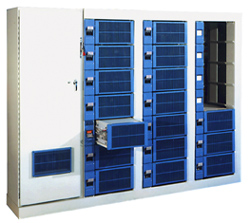|
|
DC Power Supplies
Series 1800 Primary SCR Modular
|
The Series 1800 is a modular, air cooled, primary SCR, medium voltage DC power supply. The Series 1800's modular configuration provides expandability for increasing future capacity of the unit as well as redundancy for "fail safe" reliability.
Voltage Range: 240V-600V 50 or 60Hz
Current Range: 37A-36,000A
Features & Benefits
Technical Specs
Applications
FAQ
Back to DC Power Suppllies |
|
|
- Modular Expandability
- "Fail Safe" Reliability
- Air Cooled
- Simplified Installation
- Simplified Maintenance
- Completely Automatic
- Small Footprint
|
|
- Voltage Regulation +/- 0.5%
- Current Regulation +/- 0.5%
- Operating Range 0°C - 40°C
- Efficiency 85% - 93%
- Input Line Variation +/- 5% From Nominal
|
|
- Electro-coating
- Anodizing
- Electro-machining
- Electro-refining
- Plating
|
|
- What size rectifier do I need?
Rectifier sizing has many variables including, part size, anode cell sq. footage, chemical / paint characteristics and process time. The chemical / paint or the system supplier usually recommends the rectifier size required for the process.
- Which is better air or water-cooling?
The environment where the rectifier will be placed usually determines the best type of cooling. For harsh, corrosive, or high temperature environments water-cooling is best suited.
- What is the difference between the modular (Series 1800 & 2400) and the single transformer (Series 50 & 30) rectifier designs?
The main difference between the designs is redundancy. The modular (Series 1800 & 2400) use primary SCR's for regulation. The SCR's supply the AC voltage to the module breakers that pass the AC voltage to the module transformer primary. The module transformer secondary is connected to a diode bridge for full wave rectification. The modules may be paralleled for the output current level required. The paralleling of modules provides redundancy. A module failure will trip the module breaker and the unit will automatically de-rate its current output capability by the current rating of a module. The current rating of a module varies in accordance with its voltage rating. The modular design may also be purchased with expandability, which allows the rectifier to grow with your business. The low voltage single transformer design (Series 30) uses primary SCR's for regulation. The SCR's supply the primary of the transformer. The transformer has a star secondary with a diode connected to each leg for rectification. This design requires fewer components than the modular design. The high voltage single transformer design (Series 50) uses SCR's on the secondary of the transformer for regulation and rectification. This design requires fewer components than the modular design and is slightly more efficient.
- Do I need a ripple filter?
Ripple is the small AC voltage or current occurring in a DC component as an unavoidable byproduct of rectification. Ripple filtering is a combination of inductance and capacitance used to reduce the level of ripple. Ripple filtering is required on most paint and chrome processes where a decorative or good finish is required. Filtering is also required for strict regulation or AC sensitive loads. See Option # 12235
- Which leg of the rectifier is grounded?
The rectifier output is isolated allowing either leg to be grounded per process requirements.
- Can I control or monitor the rectifier with my PLC?
Controlled Power offers as an option, a single channel, computer interface card for monitoring or control of the rectifier. The computer interface card can be configured for 0 to 10 volt, 0 to 5 volt or 4 to 20 mA signals. One card is required for each signal to be controlled or monitored. See Option # 12231
- How can I reduce the floor space needed for rectifiers used in my process?
Controlled Power can custom design rectifier cabinets for limited floor space, single side access or provide multiple units in one enclosure.
- Do I need a separate feeder transformer for the rectifier?
The rectifier does not require a separate feeder transformer however the rectifier will introduce noise, transients and harmonics on the lines that may interfere with other equipment. A K-rated transformer is recommended.
- When do I need a DC switch?
A DC switch is used for output isolation and may be configured for various applications. When down time is unacceptable, DC switches on the production unit and a stand-by unit provide a quick means of switching operation and isolation to provide safety for repair personnel. When multiple rectifiers are operated in parallel, for high power levels, each unit may have a DC switch. The DC switch provides isolation in the event of a rectifier failure. The failed unit may be safely repaired while running reduced production with the other unit. For multi zone operation a standby unit may have a DC switch selectable to any zone. A DC switch may also be configured to switch one rectifier between multiple tanks. See Option # 13000
- How can I be 100% sure of rectifier operation?
An optional under voltage meter relay can be provided to insure process voltage within a selectable range. Any deviation of output voltage from its set point could indicate rectifier trouble that could lead to lost product. See Option #12238
- How can I increase my rectifier current output?
If you have a modular system that was purchased with expandability you need only to install additional modules for additional current. If you have a non-expandable unit or a single transformer design unit another unit may be connected in parallel. The parallel control option will allow both units to equally share the load current. Some changes to the existing unit may be required.
|
|
|
|
|
Computer
Power Solutions - Please call : (800) 444-1938
Distributor of Uninterruptible Power Systems (UPS) and DC Power Systems,
Small and Large UPS Products, Rack Mount UPS Products, Enclosure Solutions. |



